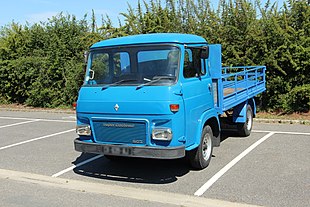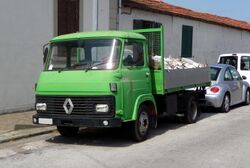Engineering:Renault Super Goélette
| Renault Super Goélette | |
|---|---|
 | |
| Overview | |
| Type | Light commercial vehicle |
| Manufacturer | Saviem |
| Also called |
|
| Production | 1965–1982 1969-2000 (Avia) |
| Assembly | Blainville-sur-Orne, France Shumen, Bulgaria |
| Layout |
|
| Powertrain | |
| Engine |
|
| Dimensions | |
| Length | 4,997–5,019 mm (196.7–197.6 in) |
| Width | 1,996 mm (78.6 in) |
| Height | 2,540 mm (100.0 in) |
| |uk|Kerb|Curb}} weight | 1,520–2,300 kg (3,351.0–5,070.6 lb) |
| Chronology | |
| Predecessor | Renault 1 000 kg |
| Successor | Renault Master/Renault B-series Avia D series (Avia models) |
The Renault Super Goélette is a van from the small commercial vehicle range (GVW of 3.3 tonnes and 3.5 tonnes) manufactured by Saviem and marketed by Renault from 1965 to 1970, then from 1971 to 1980 by Saviem and finally by Renault Véhicules Industriels (RVI) between 1980 and 1982.
History
In June 1965,[1] the Renault Super Goélette SG2 replaced the Goélette with new features: wide curved windscreen, replacement of the sheet metal dashboard, steering wheel shifter, front independent, variable flexibility suspension with coil springs (rear leaf spring suspension in 1967[2]), telescopic shock absorbers and high ground clearance. However, the gasoline engine remained of the earlier "Étendard" type (as used in the Renault Frégate). The diesel engines were of a swirl chamber design, a 2.7-liter Saviem 580-03 was fitted to the SG 2 D and the 3-liter 591–01 to the SG 4 D.[3]
In the fall of 1966,[2] the front end was revised: the windshield is enlarged downward, the grille is changed by abandoning its central bar and new lights were bi-colored. Inside, the dashboard was slightly changed.
In 1967, the rounded headlights became rectangular and two new variants appeared: the first a four-wheel-drive version (later called Saviem TP3)[4] and the second a front-wheel-drive called Trafic SB2. This latest version was especially designed for urban deliveries, offering a low loading floor. The shifter was moved to the floor and the rear axle was rigid with springs.[5] The diesel version switched to a version of Saviem's 3.0-litre four-cylinder, now with a MAN-licensed direct injection system. Two different outputs were available.[3] Moreover, the Super Goélette SG2 was called Alfa Romeo-Saviem A15 in Italy.[6] Saviem partner MAN marketed the SG2 in Germany , naming it MAN 270.[7]
For 1969 models, the diesel versions were updated to the 712 series, still with MAN's direct injection but with a longer stroke and now displacing 3.3 litres.[3] In 1971 a three-speed automatic transmission became available on the Super Goélette SG2. From 1970 the Super Goélette SG2 and SB2 Traffic were rebranded as the Saviems SG2 and SB2.[8]
In January 1974, the SG3, incorporating dual rear wheels and rear suspension with leaf springs entered production. For 1977, the external appearance was again modernised with a large black plastic grille. On 21 April 1980, following the merger of Berliet and Saviem, the small range was sold under the RVI marque.
The SG2 van was common in the 1970s before being replaced by the Master in 1980. In 1982, the remaining SG3 range was replaced by the B-series. However, the SG2 and SG3 continued in production for certain export markets. Later, SG2 and SG3 were manufactured under license in Czechoslovakia by Avia, and these were also sold with Renault badging in some countries until the mid-1990s. Production of the Avia variant continued with many facelifts and modernizations until 2000, when it was replaced by the Avia D series.
The truck was also produced at the state-owned "Madara" Lorry Works in Shumen, Bulgaria under licence and with the technical assistance of Avia as the Madara 201.[9] The enterprise had a working cooperation with the Czechoslovak Škoda, LIAZ, Avia and Soviet GAZ enterprises.[10]
Saviem TP3
The TP3 was a militarized version of the Super Goélette van. It started being produced in 1969 and was designed to replace Renault's own 2087 Goélette 4x4 and the Simca Marmon, being also available as a platform truck and ambulance for use by the French army. The TP3 was presented at the Satory Military Equipment Exhibition in 1969. It had some differences from the civilian version, including a more powerful engine intended for the harsher conditions that the truck was supposed to be subjected to alongside the gearbox from the Saviem SM8. Production ended in 1983 after nearly 11,000 vehicles had been produced. Some vehicles were also exported overseas and a small number was also sold to civilian operators.
The TP3 was succeeded by the Renault Messenger 4x4 and the bigger Renault TRM 2000, based on the civilian Saviem J and H models.
References
- ↑ Jean-Gabriel Jeudy, Les camions de chez nous en couleurs, Editions E.T.A.I.
- ↑ 2.0 2.1 L'argus, 6 October 1966.
- ↑ 3.0 3.1 3.2 "Étude Technique: Saviem SG 2 D - SG 4 D" (in fr). Revue Technique Diesel (E.T.A.I.) (57D). September 1972. http://vieux.tracteurs.free.fr/pdf/renault_type_580_003.pdf.
- ↑ Charge-Utile n°142, October 2004.
- ↑ L'argus, 7 December 1967.
- ↑ Wilding, A. J. P. (10 November 1967). "Lightweights in the limelight". Commercial Motor (London: Temple Press) 126 (3242): 112–113. ISSN 0010-3063.
- ↑ Wilding, A. J. P. (8 September 1967). "MAN changes through the range at Frankfurt". Commercial Motor (London: Temple Press) 126 (3234): 43. ISSN 0010-3063.
- ↑ Jean-Yves Brouard and Michel Fontany: Les véhicules du service public de chez nous, Editions MDM.
- ↑ "Commercial leaflet for the Madara 201". 21 November 2017. https://farm5.static.flickr.com/4170/34420329416_d9466caf13_b.jpg.
- ↑ "KTA Madara". https://www.balkancar.org/index.php/fr/older-products-new/80-kta-madara.
Sources and further reading
- The entry incorporates text translated from the corresponding French Wikipedia entry as of 4 March 2015.



